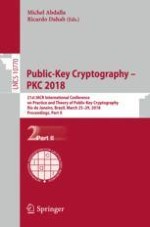2018 | OriginalPaper | Buchkapitel
Graded Encoding Schemes from Obfuscation
verfasst von : Pooya Farshim, Julia Hesse, Dennis Hofheinz, Enrique Larraia
Erschienen in: Public-Key Cryptography – PKC 2018
Aktivieren Sie unsere intelligente Suche, um passende Fachinhalte oder Patente zu finden.
Wählen Sie Textabschnitte aus um mit Künstlicher Intelligenz passenden Patente zu finden. powered by
Markieren Sie Textabschnitte, um KI-gestützt weitere passende Inhalte zu finden. powered by
Abstract
-
We can prove that the multilinear decisional Diffie–Hellman (MDDH) assumption holds in our setting, assuming the used ingredients are secure (in a well-defined and standard sense). Hence, our GES does not succumb to so-called “zeroizing” attacks if the underlying ingredients are secure.
-
Encodings in our GES do not carry any noise. Thus, unlike previous GES constructions, there is no upper bound on the number of operations one can perform with our encodings. Hence, our GES essentially realizes what Garg et al. (EUROCRYPT 2013) call the “dream version” of a GES.
